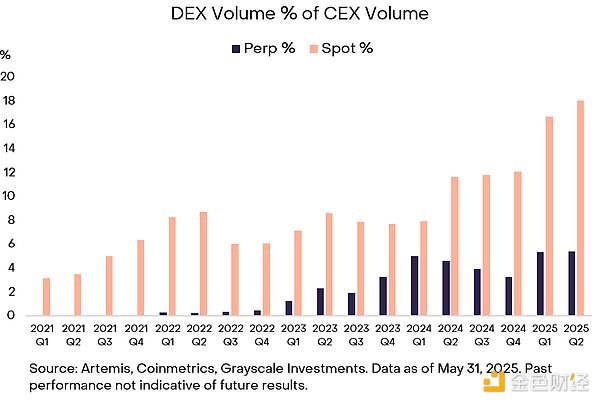Author: Michael Zhao & Zach Pandl, Grayscale; Translation: Zach from Jinse Finance
Just as in traditional finance, exchanges are the core infrastructure of the digital asset industry. Although decentralized exchanges (DEX) currently focus primarily on crypto asset trading, the trading volume of stablecoins and tokenized assets is expected to continue growing over time.
Cryptocurrency trading is still dominated by centralized exchanges (CEX), which adopt traditional corporate structures. However, the industry is increasingly "eating its own dog food": an increasing volume of trading is shifting towards decentralized exchanges (DEX), with the explosive growth of decentralized futures exchange Hyperliquid this year being clear evidence.
Decentralized exchanges (DEX) settle transactions on-chain without a centralized operator - in forms including smart contract applications deployed on blockchains like Ethereum or Solana, or exchange logic directly embedded in Layer1 protocols (such as Hyperliquid). In the first five months of 2025, DEX accounted for 7.6% of total cryptocurrency trading volume.
While cryptocurrency exchanges can benefit from trading volume growth, they also face competitive pressure in transaction fees. Grayscale Research anticipates that CEX will continue to dominate trading of high-market-cap assets like Bitcoin, but DEX will become the preferred platform for long-tail asset trading and for users who value the transparency and accessibility of permissionless global platforms.
Public blockchains provide digital business solutions without centralized intermediaries. However, to attract users, decentralized technology must offer features at least as attractive as centralized solutions. If decentralized applications are inferior to centralized solutions in speed, cost, and historical data, blockchain activity will likely remain only a small part of the online commercial landscape.
Fortunately, after years of exploration, we have witnessed decentralized applications competing directly with traditional institutions in token trading, the core area of cryptocurrency. Grayscale Research estimates that DEX currently accounts for 7.6% of global cryptocurrency trading volume (only 3% in 2023), with its trading volume share significantly increasing relative to CEX (Figure 1). Today, DEX is on par with CEX in pricing, often has higher transparency, and frequently serves as the primary trading venue for newly issued on-chain assets.
Figure 1: DEX trading volume growth relative to CEX has more than doubled since 2021

This year is likely to be an industry turning point, with technological advances and regulatory clarity driving user adoption of DEX and other DeFi applications. This article will provide a comprehensive overview of the DEX industry, including industry structure, competitive landscape, and development prospects. Grayscale Research believes that market leadership will ultimately concentrate on a few top platforms - possibly only one or two exchanges in each segment (CEX vs DEX, spot vs perpetual contracts) - that combine deep liquidity, capital-efficient infrastructure with attractive token or equity economic models.
[The rest of the translation continues in the same manner, maintaining the professional and technical tone while accurately translating the text.]3. Evolution of Decentralized Exchanges
The development of decentralized exchanges has shown clear stage-by-stage breakthroughs, with each generation overcoming the limitations of its predecessors. Early attempts (2017-2018) - such as EtherDelta's order book model, 0x protocol's off-chain relay solutions, and Bancor's pioneering AMM liquidity pools - while validating the feasibility of decentralized trading, faced significant challenges in user experience and liquidity. The launch of Uniswap in 2018 was a turning point, with its simplified AMM model and intuitive interface greatly improving accessibility, paving the way for the explosive growth in trading volume and total locked value during the "DeFi Summer" of 2020.
Further optimizations from 2021 to 2023 - especially Uniswap v3's concentrated liquidity design, and innovations by Perpetual Protocol and GMX in perpetual contracts - significantly improved capital efficiency and enabled more refined on-chain derivatives trading. The recent stage (2023-2025) has seen the emergence of on-chain CLOBs like dYdX Layer1 on Cosmos and Hyperliquid's ultra-high-speed custom blockchain, combining the speed and precision of centralized exchanges with DeFi's transparent decentralized characteristics.
The current daily average trading volume (ADV) for cryptocurrency DEXs in spot and perpetual contracts is approaching $10 billion (Figure 4), compared to around $150 billion for NYSE Group platforms. The growth in DEX perpetual contract trading volume is primarily driven by Hyperliquid, accounting for approximately 80% of the total perpetual contract daily average trading volume.
[Rest of the translation follows the same professional and accurate approach]6. Conclusion
Decentralized exchanges have evolved from an experimental concept to the core infrastructure for on-chain asset expansion. As the scale of stablecoins grows, real-world assets accelerate migration to public chains, and blockchain space costs decrease, DEX's share in daily transactions will continue to expand—especially for emerging tokens or niche markets that have never touched centralized order books. CEXs will still maintain advantages in high nominal value and low-latency sensitive transaction flows. However, the long-term competitive landscape is more grand: cryptocurrency exchanges are collectively poised to challenge traditional exchanges, launching an impact in asset custody, liquidity provision, and price discovery mechanisms for tokenized stocks, bonds, and other areas. In short, the question is no longer "Is DEX important," but how quickly its transparent and programmable infrastructure will redefine the "exchange" of the next decade.






